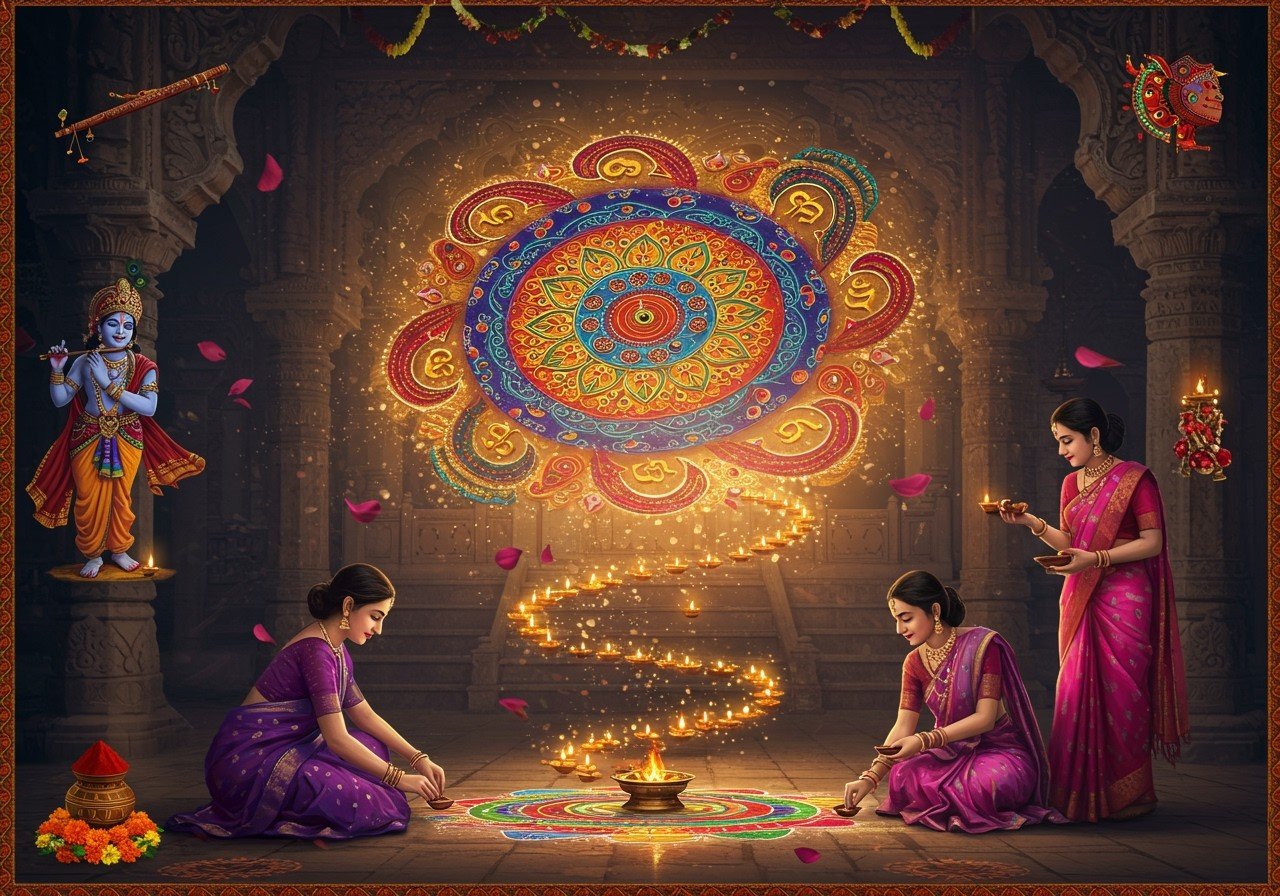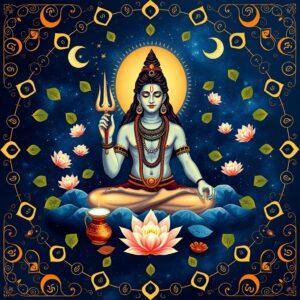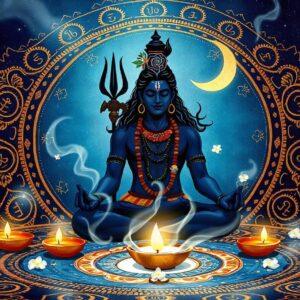
Rangoli, an ancient Indian art form, holds a significant place in Hindu culture, especially during festivals. These colorful and intricate designs are more than just decorative pieces; they carry deep cultural and spiritual meanings. This blog explores the connection between Rangoli and Hindu festivals, highlighting the various types of Rangoli, their symbolism, and specific designs for different festivals. We will also explore how poojn.in can assist you in acquiring the necessary materials to create stunning Rangolis.
The Art of Rangoli and its Connection to Hindu Festivals
Rangoli is traditionally created on floors using materials like colored rice, dry flour, colored sand, or flower petals. It is a symbol of auspiciousness and is believed to bring good luck and prosperity. During Hindu festivals, Rangoli plays a crucial role in home decorations and rituals.
Historical Origins
Rangoli dates back to ancient times and has evolved over the centuries, influenced by various regional cultures. The designs and methods of creating Rangoli differ from one state to another, reflecting the rich diversity of Indian traditions.
Cultural Significance
In Hindu households, Rangoli is especially important during festivals. It symbolizes joy, celebration, and the invitation of positive energy into homes. The vibrant colors and patterns are believed to attract divine blessings.
Materials Used
Traditional materials like rice flour, colored powders, and flower petals each have their symbolic meanings. For instance, rice flour represents purity and devotion, while flower petals signify beauty and nature’s abundance.
Inviting Deities
Rangoli designs are often placed at entrances to welcome deities into homes during festivals. This practice is believed to attract divine blessings and grace, signifying reverence and respect for the divine.
Regional Variations
Different states and communities in India have their unique styles of Rangoli, reflecting local traditions and folklore. These variations showcase the diverse artistic expressions across the country, each with its own distinct charm.
Festive Atmosphere
Rangoli helps create a festive atmosphere and brings people together in the community, fostering a sense of unity and shared celebration. It transforms homes and public spaces, infusing them with the vibrant spirit of the festival.
Modern Adaptations
While traditional elements are preserved, modern Rangoli designs incorporate contemporary themes and materials. These adaptations keep the tradition alive while allowing for creative expression and innovation.
Different Types of Rangoli
Rangoli art varies widely in its styles and materials used, each type having its unique charm and significance.
Alpana
A Bengali style made with a paste of rice and water, Alpana is known for its intricate patterns and flowing designs. It is traditionally created during religious ceremonies and festivals.
Kolam
Popular in Tamil Nadu, Kolam is created using rice flour or chalk powder, often featuring geometric designs. It is believed to bring prosperity and is a daily ritual in many households.
Mandana
A Rajasthani style made with lime or chalk and red ochre, Mandana is known for its vibrant colors and bold patterns. It often depicts symbolic motifs related to nature and mythology.
Pookalam
A floral Rangoli from Kerala, typically made during the Onam festival with colorful flower petals. It is a vibrant and fragrant expression of art and celebration, unique to the region.
Muggulu
From Andhra Pradesh and Telangana, Muggulu is characterized by geometric patterns and often created with rice flour. It is an integral part of festivals and celebrations in these states.
Symbolism and Meanings of Rangoli Patterns
Each Rangoli design is imbued with symbolism and carries specific meanings, often linked to the festival being celebrated.
Common Patterns
Flowers, conch shells, and lamps are common patterns in Rangoli, each carrying symbolic meanings. Flowers represent beauty and prosperity, conch shells symbolize purity, and lamps signify light overcoming darkness.
Colors Used
The colors used in Rangoli have associated emotions and spiritual connotations. Red signifies strength and passion, yellow stands for knowledge and learning, and blue represents calmness and tranquility.
Geometric Patterns
Geometric patterns in Rangoli represent the cosmos and the universe’s balance. They symbolize harmony, order, and the interconnectedness of all things.
Animal Motifs
Peacocks, elephants, and other animal motifs are popular in Rangoli designs. Peacocks symbolize beauty and grace, while elephants represent wisdom, strength, and good fortune.
Deities and Religious Symbols
Depictions of deities and religious symbols in Rangoli are common during specific festivals. These designs show devotion, reverence, and the celebration of divine presence.
Rangoli Designs for Diwali
Diwali, the festival of lights, is one of the most significant Hindu festivals. Rangoli plays a crucial part in its celebrations, adding to the festive ambiance and spiritual significance.
Traditional Diwali Designs
Diyas (lamps) and Lotus flowers are common motifs in Diwali Rangoli. They symbolize joy, prosperity, and the triumph of light over darkness, reflecting the essence of the festival.
Vibrant Colors and Patterns
During Diwali, vibrant colors and intricate patterns are used in Rangoli, highlighting the festival’s spirit of celebration and joy. The colorful designs enhance the festive atmosphere and create a sense of vibrancy.
Welcoming Goddess Lakshmi
Creating Rangoli at the entrance of homes during Diwali is believed to welcome Goddess Lakshmi, the goddess of wealth and prosperity. It is a symbolic gesture of inviting blessings and abundance into the home.
How Poojn.in Helps You Create Beautiful Rangoli Art for Hindu Festivals
Poojn.in, India’s largest Dashakarma bhandar, offers essential items for creating traditional Rangoli designs during Hindu festivals. Our authentic Rangoli colors come in vibrant shades that match the festive spirit of celebrations like Maha Shivaratri and Shravan Maas.
For creating stunning Rangolis, explore our diverse collection of Rangoli colors and accessories available at www.poojn.in. We offer a wide range of colors, stencils, and tools to help you create intricate and beautiful Rangoli designs for any occasion.
We also stock complete puja kits containing essential items like Rangoli colors, puja thalis, diyas, incense sticks, and other ritual items needed for festival celebrations. You can find all your festive needs conveniently at www.poojn.in.
Embracing Tradition with Modern Convenience
Rangoli beautifully bridges ancient traditions with contemporary life. Its vibrant colors and intricate patterns bring joy and positivity to every Hindu festival. While rooted in deep cultural significance, Rangoli has adapted to modern times, preserving tradition while embracing new ideas.
Creating Rangoli during festivals is more than just decoration; it is a way of inviting divine blessings, fostering unity, and celebrating cultural heritage. Whether you are a seasoned artist or a beginner, making Rangoli can be a deeply fulfilling experience. Explore a variety of rangoli designs at Ganesh Chaturthi Rangoli Designs and Holi Rangoli Designs.


